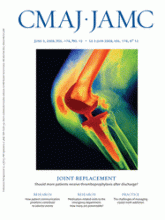Data supplements
Résumé
Incidence, severity and preventability of medication-related visits to the emergency department: a prospective study
Peter J. Zed PharmD, Riyad B. Abu-Laban MD MHSc, Robert M. Balen PharmD, Peter S. Loewen PharmD, Corinne M. Hohl MD, Jeffrey R. Brubacher MD MSc, Kerry Wilbur PharmD, Matthew O. Wiens BSc(Pharm), Leslie J. Samoy BSc(Pharm), Katie Lacaria BSc(Pharm), Roy A. Purssell MD
Contexte : Les consultations à l’urgence en lien avec la prise de médicaments sont un phénomène courant mais mal compris. Nous avons cherché à évaluer la fréquence, la gravité et le caractère évitable des consultations à l’urgence associées à la prise de médicaments.
Méthodes : Nous avons effectué une étude d’observation prospective auprès d’adultes sélectionnés aléatoirement qui ont consulté à l’urgence au cours d’une période de 12 semaines. Les consultations à l’urgence ont été considérées associées à la prise de médicaments à partir d’une évaluation effectuée par un assistant de recherche en pharmacie et un urgentologue; deux évaluateurs indépendants ont tranché quand les cas ne faisaient pas l’unanimité.
Résultats : Parmi les 1 017 patients inscrits à l’étude, on a associé la consultation à l’urgence à la prise de médicaments chez 122 patients (12,0 %, intervalle de confiance IC à 95 %, 10,1 %–14,2 %); parmi ces cas, 83 consultations (68,0 %, IC à 95 %, 59,0 %– 76,2 %) ont été jugées évitables. L’intensité a été jugée légère chez 15,6 % de ces 122 cas, modérée chez 74,6 % et grave chez 9,8 %. Les raisons les plus fréquentes des consultations liées à la prise de médicaments étaient des réactions indésirables (39,3 %), une piètre fidélité au traitement (27,9 %) et l’utilisation du mauvais médicament ou d’un médicament suboptimal (11,5 %). La probabilité d’hospitalisation était significativement plus grande chez les patients qui consultaient en lien avec la prise de médicaments que chez les patients dont la consultation n’était pas liée à la prise de médicaments (RC 2,18, IC à 95 %, 1,46–3,27, p < 0,001) et parmi les sujets hospitalisés, la durée moyenne du séjour a été plus longue (8,0 intervalle interquartile 23,5 c. 5,5 jours intervalle interquartile 10,0, p = 0,06).
Interprétation : Plus d’une consultation aux urgences sur neuf est causée par des événements indésirables liés à la prise de médicaments, un problème potentiellement évitable dans notre système de santé.
Affiliations : From the Department of Pharmacy (Zed), Queen Elizabeth II Health Sciences Centre, Capital Health, Halifax, NS; the Department of Emergency Medicine and College of Pharmacy (Zed), Dalhousie University, Halifax, NS; the Department of Emergency Medicine (Abu-Laban, Hohl, Brubacher, Purssell) and the Pharmaceutical Sciences Clinical Services Unit (Samoy, Lacaria), Vancouver General Hospital, Vancouver, BC; the Faculty of Medicine (Abu-Laban, Hohl, Brubacher, Purssell) and the Faculty of Pharmaceutical Sciences (Balen, Loewen, Wiens), University of British Columbia, Vancouver, BC; Pharmacy Services (Balen), Royal Columbian Hospital, New Westminster, BC; Pharmacy Services (Loewen), Vancouver Coastal Health — Providence Health Care, Vancouver, BC; and the Pharmacy Program (Wilbur), Qatar University, Doha, Qatar
Correspondance : Dr Peter J. Zed, Queen Elizabeth II Health Sciences Centre, Department of Pharmacy — Halifax Infirmary, 1796 Summer St., Halifax NS B3H 3A7; fax 902 473-3904; peter.zed{at}dal.ca
Online Appendices
Files in this Data Supplement:











